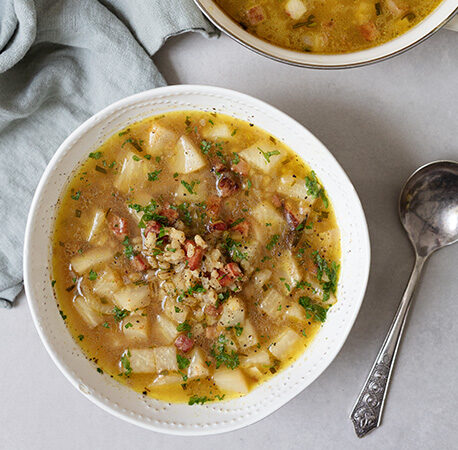In this installment of her Eat Ireland column, Deputy Editor Jocelyn Doyle shares her long standing love of this Irish goat’s cheese.
I don’t think anyone will be surprised to learn that food is one of my main obsessions, nor that cheese holds a very special, very hungry place in my heart. What you might not know, however, is that I’ve been in love with Siobhán Ní Ghairbith’s St. Tola goat’s cheese since I was first lucky enough to taste it over 15 years ago.
I eat a lot of cheese; some would say too much, but my doctor tells me — with some bafflement — that my cholesterol levels are fine, so I ain’t giving up any time soon. I’m an equal opportunity cheese eater, happy to worship at the altar of anything and everything from everyday red Cheddar to the stinkiest, funkiest blues and weeping, over-ripe bloomy rinds I can find. Some cheeses pass through my life without making too much of an impact, while others immediately announce themselves as new lifelong lovers. St. Tola is one of the latter, a food of pure beauty. Its soft, wrinkled, yellowed rind speaks of untold mysteries within, while its funky scent hints at its complexity, a sure indicator of quality. I’ve been excited to eat it every time since the first, when its flavours began to come alive in my mouth and I knew this was something truly unique.
Aside from the gorgeous experience of actually eating St. Tola, I never fail to be impressed by Siobhán’s commitment to sustainability, a trait sure to spark my interest in any food producer. The farm was registered as organic for many years, but poor weather made it impossible to produce enough quality fodder themselves and buying it was prohibitively expensive, a cost too high to pass on to the consumer. However, Siobhán feels that sustainable farming is equally important and very achievable. As she tells me, “It’s all about the land and the farm for me, and that is why I do what I do. We need to look after the land and the environment so that it is there for future generations. From the way we farm to the ingredients and packaging we use, sustainability is at the forefront of what we do.”

With this in mind, St. Tola is part of the Burren Eco-tourism Network as well as Bord Bia’s Origin Green plan. The goats are outdoors as much as possible; when the weather keeps them in their spacious housing, a deep litter system makes use of manure as a natural fertiliser. Siobhán also has a rain harvesting system in place, along with a waste water recycling unit and solar panels, and she’s keen to spread her message. “We tell visitors to the farm about our sustainability ethos and encourage all those who visit to think how they can contribute to a more sustainable world in their lives.”
A typical day begins at 8am with feeding and milking the goats, and the cheesemaking starts at the same time. All stages of the process are carried out every day, from adding the starter and rennet to the milk right up to maturation. Orders are packed and collected each day. “This time of the year we have a farm tour most days, and anybody else could turn up too, from a Michelin star chef to visitors touring the Burren,” says Siobhán.
The farm is a beautiful testament to an older, less intensive way of farming. St. Tola goats are reared on 65 acres of unspoiled pasture and are free to roam outdoors when the weather is warm and dry, grazing on the herb rich pastures feeding on wild flowers. During the harsh winter, they are housed indoors in comfortable, spacious sheds and are fed on hay grown on the farm during the summer, supplemented with GM-free grains.
The farm’s location in West Clare has an enormous impact on the cheese itself. “It’s all about the terroir,” says Siobhán. “Our land is peaty and our fields are full of fresh herbs and flowers including wild clover, honeysuckle, buttercups and wild garlic.” As the goats graze across the pastures, their milk becomes influenced by these flavours, as well as by the salt winds blowing in from the Atlantic Ocean just 10km away. This terroir effect also means that there are subtle differences in St. Tola throughout the year.
An active member of Slow Food and one of Fáilte Ireland’s Food Ambassadors, Siobhán is passionate about the benefits of raw milk and uses raw milk from her own goats in cheesemaking, but — under Irish regulation — must pasteurise any supplemental milk she buys in. “There are differences in texture and flavour. Our raw milk cheeses are denser and drier in texture, and the flavours are more pronounced and distinctive. In the cheeses made from pasteurised milk, the texture is softer and the flavours are less distinguished.”

For Siobhán, one of the most important considerations is quality. “We are very much about high-quality, natural cheese, as close to nature as possible. We only use 1% salt so the shelf–life is short, at a maxmum of six weeks, but the distinctive flavours of the land come through. We are passionate about using raw milk as much as possible. We also develop a natural rind, which is more difficult to create and handle, but it adds to the uniqueness of what is St. Tola.”
Siobhán grew up next door to Meg and Derrick Gordon, the original makers of St. Tola, and her interest developed from watching them as a child. Since she took over in 1999, the farm has grown from 70 goats to a herd of 300, producing four times the amount of cheese it did then. So what’s next for the farm? “It’s not about getting bigger,” says Siobhán, “but getting better at what we do. The farming aspect is very challenging due to the climate, but it is also what makes St.Tola so distinctive. If it was only about making profit, then it would make more sense to stop farming and just buy in milk, but that just isn’t me.
“We plan to keep improving the quality of our herd — and hence the milk and cheese — through our sustainability and maturing plans, and to keep researching and creating new cheeses on a smaller scale.” Perhaps as a result of her previous career as a primary school teacher, she’s also passionate about continuing to educate customers about the cheese and the farm’s ethos of sustainable practices.

Siobhan recommends enjoying St. Tola when it’s mature and has more depth and personality, with which I wholeheartedly agree. This summer, I’ll be continuing my happy love affair with St. Tola by making these delicious tartines, the perfect combination of summer flavours and just crying out to be enjoyed outdoors. I’m not a jealous girlfriend, though; if you fall in love with St. Tola, too, I will completely understand.
- summer events
- small business
- gut health
- OATLY
- healthy
- Crudo
- top tips
- All Together Now
- fridge cake
- Events Waterford
- me auld flower
- Events Ireland
- food festival
- news
- dublin
- events Dublin
- dublin festival
- Home-Cooking
- food and drink festival
- online cooking course
- festival line-up
- cooking
- Summer festival
- eco-friendly
- Events
- cosy
- Festivals Ireland
- wine
- Body & Soul
- grapes
- music festival
- south africa






You have to be signed in to comment this post.